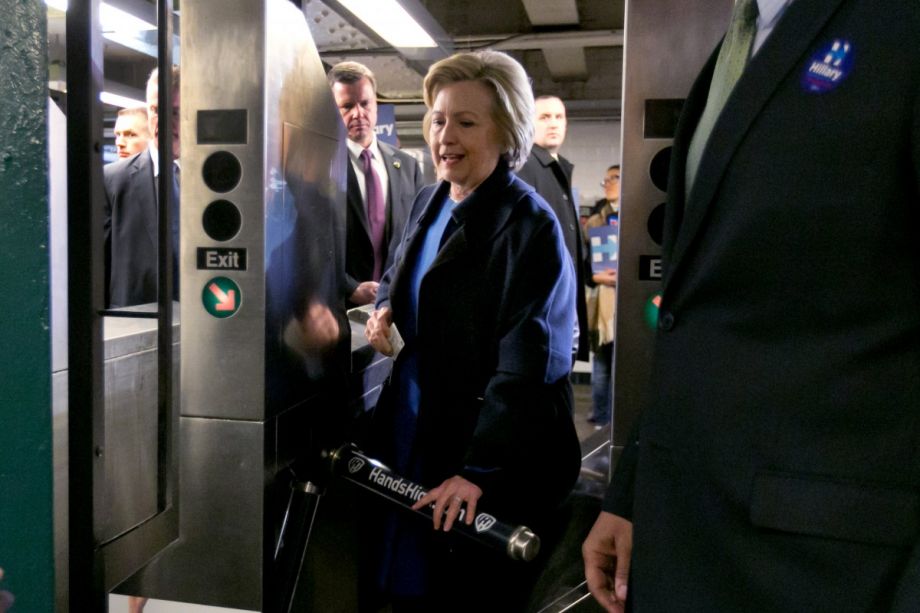The 2016 presidential race hit New York City last week, and the candidates worked the subway trains to show how they were just like the rest of us in traveling the city. Of course, all did not go perfectly. Hillary Clinton had trouble with her Metrocard: She took five swipes to get through the turnstile. (“Saturday Night Live” had some fun with the incident; see below at 2:12.) Meanwhile, Bernie Sanders was looking to buy a token, and NYC hasn’t used tokens since 2003.
Republican candidate Ted Cruz was in the transit mix too: Perhaps in response to his remarks earlier this year expressing disdain for “New York values,” the New York Daily News decided to give Cruz some free travel advice. The tabloid told him to use subway trains identified with the sixth and 21st letters of the alphabet as the best way to get out of the Bronx.
But the campaign photo ops in New York subway stations do raise an issue that has been on the back burner during most of this 2016 election season. As a country, we are in the middle of a radical shift in our relationship to the automobile and its role in transportation, and the current candidates aren’t speaking much to the change. Transit agencies in several U.S. cities posted record ridership last year. Commuters want more public transportation options, and they see real economic and environmental benefits to mass transit. Many are even willing to pay a little more for a better system.
While ridership has increased over the last decade, the growth has happened while funding for transit has remained relatively flat, and many systems are aging and growing more desperate for repair and upgrades. The American Public Transportation Association estimates national mass transit systems need about $86 billion worth of repairs just to get them functional without any growth.
So where do the candidates stand on all of this? On the GOP side, Cruz last fall put the New Starts Transit Program on his list of federal programs he would end as president, and he voted no in December on the first true multi-year transportation bill passed since 2005. But Donald Trump has expressed more than once what seems like jealousy of other countries’ “super-speed trains.” He told The Guardian last year the U.S. has to spend more on mass transit, but he hasn’t yet explained exactly where funding will come from. Last month, Time reported, he sounded like a Democrat when discussing infrastructure investment, albeit with few details.
Trump has admitted that rebuilding American infrastructure would cost taxpayer dollars. But then waved away the concern with Trumpian bravado.
“On the federal level, this is going to be an expensive investment, no question about that. But in the long run it will more than pay for itself,” he said. “It will stimulate our economy while it is being built and make it a lot easier to do business when it’s done—and it can be done on time and under budget.”
On the Democratic side, both Clinton and Sanders think more spending on mass transit is needed too. Sanders wants to spend $1 trillion over five years on infrastructure, which will include mass transit improvements. That includes an extra $75 billion a year for states to address their backlog of projects, to include roads, bridges and transit.
Clinton wants to increase spending by $275 billion over five years on those three things as well. She doesn’t define how much goes to mass transit and how much to road building.
The two do differ on the way the money would be spent. Sanders wants to increase the spending, but disburse it in much the same way it has been for decades. Clinton, on the other hand, wants to make a major change: have more ways that the federal money can go directly to the transit systems for capital projects and bypass state control.
In the past few decades, states have taken more of a lead role in how transportation funds are spent. There is no standard for how much each state spends and how, but there is one certainty: Urban mass transit systems have suffered — either through lack of maintenance or lack of expansion — when governors and state legislatures have seen mass transit expenditures as wasteful.
And in some ways, the process of how the money is spent needs to be part of the discussion right now. About $60 billion a year is spent in total on mass transit in this country, and it breaks down like this: About 25 percent comes from fares, 20 percent from the federal government, and the rest from state and local sources. In the past, the federal government share was used to for capital improvement projects, say light-rail expansions or buying new buses.But over time, many states — which have great control over disbursing the federal funds — have cut their contributions and the federal contributions are being used more and more for basic operating costs. That’s why the systems are $86 billion in the hole in maintenance capital projects, while at the same time not doing much expansion either.
While Sanders’ plan is an improvement over the status quo, giving more money to some governors who have favored spending on suburban sprawl over urban mass transit doesn’t change much. It might add some highway lanes and make bridges safer, but it won’t necessarily move mass transit projects ahead of those. Clinton’s plan is also a little short on specifics, but it does seem to have some changes that will allow for a better one-on-one relationship between the federal and local governments when trying to fund capital improvements that could include expansion of the existing mass transit system.
For example, Nashville has worked hard in recent years to build a bus rapid transit line in the city, only to have it blocked by Tennessee’s Republican-controlled legislature. Clinton’s plan could make it easier to implement local plans, because the federal grants under her proposal would be project specific and not part of an overall state funding package.
Regardless of the differences between Clinton and Sanders, whoever is the Democratic nominee for president might move the needle a few points in their favor in key swings state like Ohio and Florida by prioritizing mass transit funding reform and expansion of services. For her part, Clinton jaunted down to Baltimore yesterday and specifically noted that the city’s once-planned Red Line, nixed by Republican Gov. Larry Hogan, “should have been completed.”









